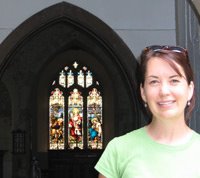42: St. Nicholas
Jane Austen had an idyllic childhood. This is easy to say, since I did not live her childhood (and it is what I imagine people would say about my own, although my own didn’t feel that way—normal, maybe, free of tragedy, but not idyllic).
This was just one of the thoughts threading through my mind as I sat on a bench in the graveyard of St. Nicholas church in Steventon Monday morning. Jane, my friend from the Abbey, had finished her retreat yesterday and gone back home, but offered to drop me here today on her way to Basingstoke. I had not rented a car, not wanting to attempt driving on the wrong side of the road, with no one to navigate. Only, I discovered, public transportation is nearly non-existent in Hampshire. So that morning Dom Nicholas knocked on my door as I was drying my hair. “The bus to Steventon has arrived. We are having coffee,” he said, in a voice that hinted of reprimand. “Be quick!”
My mind was pulsing and jumping to be here in the village where Jane spent her first 25 years. I had to—impossible to come all this way and not accomplish this—go inside the church, but as yet, the doors were stuck, or locked, or I just didn’t know how to open them. I wanted to find the site of the rectory, the old well the only remaining landmark. And I planned to spend most of the four hours I had hiking through the countryside Jane knew so well, in search of her friend Anne Lefroy’s house.
The very air seemed to buzz. My ears were opened to new noises—raucous bugs and birds, the same activity I had seen yesterday as I sat by the willow pond. I expected to find it quiet, which it was, but it was also fully alive. Every stalk of grass, every bit of water held movement. It made me remember the layers of sounds and activity that we forget about, silenced beneath our concrete and condos, drowned out by cell phones and TVs.
Most of us know little of this natural realm anymore, I suppose, but Jane would have been tuned to its cues—when the chestnuts dropped in the fall, the damage a spring storm could do, which kind of winter fronts could be weathered in thick pattens and which would leave the women housebound for weeks on end.
There are twenty or so mostly kept-up graves spread around the graveyard. Jane’s brother James and his two wives are buried here, along with some of the Digweed family who lived in the manor house when Jane was a girl. A massive yew tree fills the front yard. They used to hide the church key here until someone stole it. I think this tradition went back to Austen’s day, but I’m not sure. I looked for the key anyway, hoping for some stroke of luck, but found nothing.
The church sits at the end of a very small lane, the only cross-street in town, which turns to gravel past the churchyard. The brick manor, rebuilt, is just across this lane, and the rest of the church is surrounded by a field of high grass, through which an Englishman in shorts (someone ought to tell them not to wear shorts when they are so terribly white) was running his dogs. He thought the church would be open. I tried again. No luck. The directions for finding the site of the rectory were indecipherable; the Lefroy home—some two or three miles off—felt easier. So I set off through the fields.



0 Comments:
Post a Comment
<< Home